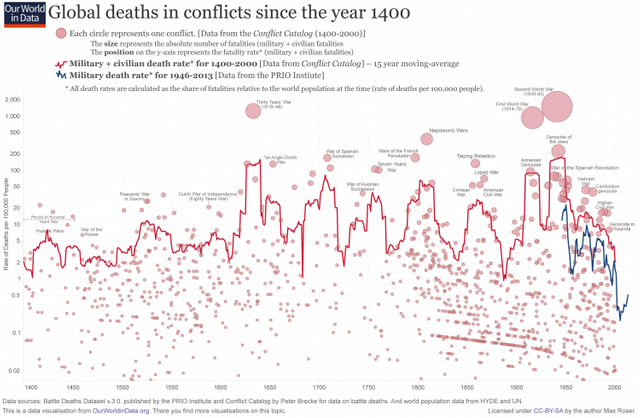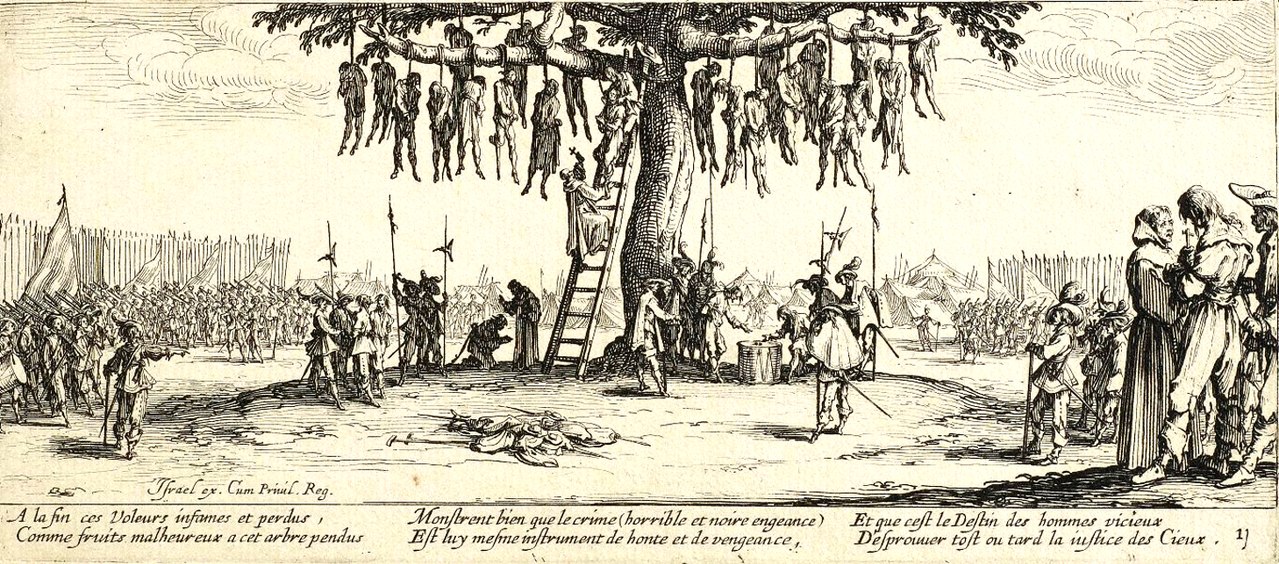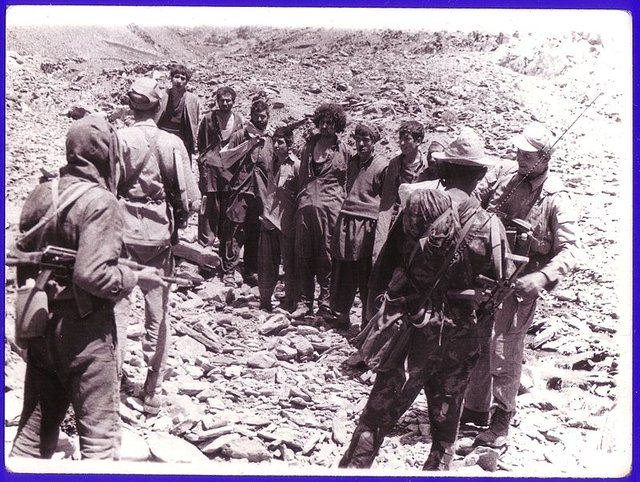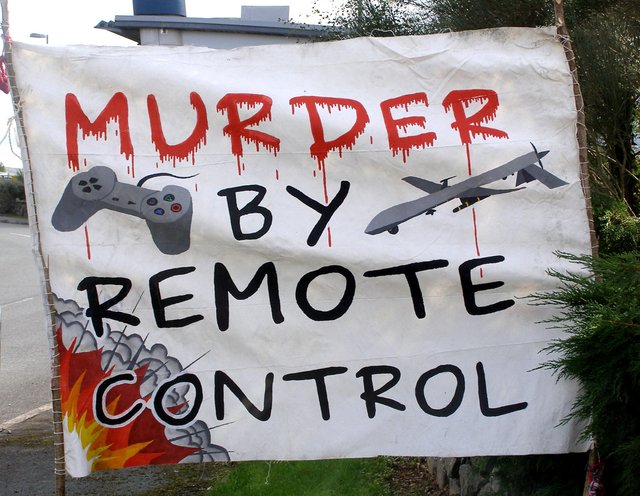Human Extermination during the 20th Century and the Myth of the “Long Peace”
“It is not death that a man should fear, but never beginning to live”.
Marcus Aurelius, Meditations

Memento Mori - Milan Nykodym Wikicommons
If you had to guess the number of human beings that were exterminated –as in government organized killings- during the 20th Century, what would you say? I’ve heard many numbers -from 30 million to 120 million- in these last days of informal surveying. While 30 million is patently wrong, since only the Second World War killed an estimated of 60 million, even the larger guess is wrong… by half.
The number is actually around 262 million, according to Italian professor Ugo Bardi, who recently published an article explaining how patterns of violence along past centuries could be used to foretell when the next extermination will happen.

Comparing past conflicts with present ones, Bardi states that during the 30 Years War (17th century) the amount of European victims oscillated around 8 million, when the total population of that continent was close to 80 million, representing a death toll of 10%. Then, in a longer lapse, the 20th century saw 262 million killed, of a total of 2.5 billion world population, keeping the same 1 in 10 ratio.

The Hanging by Jacques Callot. 30 Years War Public Domain
“All these events have a common characteristic: large events are triggered by small ones. A rolling pebble may generate a landslide while an abandoned lit cigarette may generate a forest fire. It is the same for wars, where the tendency of small wars to generate large ones is called ‘escalation’”.
The most deadly events of the 20th century, according to the Conflict Catalog, (its information details most conflicts since the 15th century and many of its numbers are debatable):
The Armenian Genocide, lasting almost ten years from 1909-18, and counting around 1,800 000 deaths.
The First World War, starting in 1914 and claiming more than 30 million deaths both military and civilian.
Chinese Civil Wars (Communist): between 8 and 12 million civilians. Source
The Spanish Revolution of 1936, costing 2 million civilian casualties.
The Second World War, of course, was the deadliest with more than 60 million total casualties.
After the Second World War, Vietnam, Afghanistan, Cambodia, Rwanda, and Congo have seen killing of civilians in considerable numbers (sometimes way over a million) as well.

Soviet forces after capturing some Mujahideen, Wikicommons
Steven Pinker’s Myth of the “Long Peace”
But let’s not despair! Pessimism doesn’t help us in being respectable and productive citizens…
The term Long Peace, coined by historian John Lewis Gaddis, was used by Pinker in his book The Better Angels of our Nature, (2011) in which he states that human kind have seen a pacification process mainly thanks to a decline in state versus state conflict, and also regarding colonial –or post-colonial- violence, since the end of the Second World War.
As philosopher John Gray argues:
“Francis Fukuyama’s declaration of ‘the end of history’ – the disappearance of large-scale violent conflict between rival political systems – was a version of the same message”.
Indeed, this is a message peddled by many, very popular liberal thinkers around the world. They have seen their message gain popularity among mainstream commentators, and now it amounts to a new “orthodoxy” to understand our brave post-modern world.
Except, of course, for its many fallacies and obvious subservience to a rather conformist and bourgeois pro-establishment outlook.
The energyskeptic’s blog reviews some of the critique, made by mane intellectuals, to Pinker’s indulgent perspective of peace:
As John Grays also states:
“If great powers have avoided direct armed conflict, they have fought one another in many proxy wars. Neocolonial warfare in south-east Asia, the Korean war and the Chinese invasion of Tibet, British counter-insurgency warfare in Malaya and Kenya, the abortive Franco-British invasion of Suez, the Angolan civil war, the Soviet invasions of Hungary, Czechoslovakia and Afghanistan, the Vietnam war, the Iran-Iraq war, the first Gulf war, covert intervention in the Balkans and the Caucasus, the invasion of Iraq, the use of airpower in Libya, military aid to insurgents in Syria, Russian cyber-attacks in the Baltic states and the proxy war between the US and Russia that is being waged in Ukraine – these are only some of the contexts in which great powers have been involved in continuous warfare against each other while avoiding direct military conflict.
While it is true that war has changed, it has not become less destructive”.
And:
“Rather than a contest between well-organised states that can at some point negotiate peace, it is now more often a many-sided conflict in fractured or collapsed states that no one has the power to end. The protagonists are armed irregulars, some of them killing and being killed for the sake of an idea or faith, others from fear or a desire for revenge and yet others from the world’s swelling armies of mercenaries, who fight for profit. For all of them, attacks on civilian populations have become normal. The ferocious conflict in Syria, in which methodical starvation and the systematic destruction of urban environments are deployed as strategies, is an example of this type of warfare”.

John McCain’s secret trip to Syria source
Proxy wars and the state of perpetual war not only normalize conflict and constant killing, it also tends to be overlooked by the mainstream media, just go ahead and ask anyone about the number of countries that are, today, occupied by large numbers of foreign militias engaging in semi-secret wars, torturing civilians in semi-secret prisons around the world, or about the toll of deaths by drones and other forms of remote killing.
Another way to sustain this establishment-friendly discourse is by overlooking the fact that most wars have moved from Europe, and the First World in general, to the Third World. Pinker also states that “democracies… tend to stay out of disputes across the board”.
This is beyond disingenuous for a man that is certainly better informed that the huge majority.
As Herman and Peterson observe:
“How does Pinker get around the seemingly large numbers of wars and militarization process that bother so many ordinary people and specialist observers such as Chalmers Johnson, Andrew Bacevich, and Winslow Wheeler? One Pinker method is to confine his focus to post-1945 wars among the great democracies, which have not fought one another in this sixty-seven-year interim, and to ignore or downplay the numerous wars that the great democracies have fought in the Third World. He calls this the “Long Peace,” while the other wars have no name. Pinker contends not only that the “democracies avoid disputes with each other,” but that they “tend to stay out of disputes across the board,” an idea he refers to as the “Democratic Peace.” This will surely come as a surprise to the many victims of US assassinations, sanctions, subversions, bombings, and invasions since 1945. For Pinker, no attack on a lesser power by one or more of the great democracies counts as a real war or confutes the “Democratic Peace,” no matter how many people die”.

Steven Pinker – Wikicommons
And then:
“It also rests on a patriotic rewriting of history and use of sources that will support this rewriting. A dramatic example is his treatment of the US-backed war in Vietnam. Pinker makes that war a case in which enemy fanaticism and the “life-is-cheap” mentality of the Vietnamese were responsible for the heavy casualties”.
And of course, some cherry-picking on his sources of information and statistics is always the way to go for successful propaganda.
As another critic, John Arquilla, states in Foreign Policy:
“The problem with the conclusions reached in the studies Pinker cites is their reliance on ‘battle death’ statistics. The pattern of the past century — one recurring in history — is that the deaths of noncombatants due to war has risen, steadily and very dramatically. In World War I, perhaps only 10 percent of the 10 million-plus who died were civilians. The number of noncombatant deaths jumped to as much as 50 percent of the 50 million-plus lives lost in World War II, and the sad toll has kept on rising ever since. Perhaps the worst, but hardly the only, terrible example of this trend can be seen in the Congo war — flaring up again right now — in which over 90 percent of the several million dead were noncombatants. As to Pinker’s battle-death ratios, they are somewhat skewed by the fact that overall populations have exploded since 1940; so even a very deadly war can be masked by a ‘per 100,000 of population’ stat”.
Now, perhaps, you won’t need to read Pinker's 800+ pages exercise in post-modern onanism, which yours truly finds extremely offensive and inhumane toward the victims of war and violence around the world throughout the 20th century and up to our days.

Recent posts on Propaganda, Informartionwar, History and news...
A Timeline for the Massive Crackdown on Internet Free Speech - Part 2
A Timeline for the Massive Crackdown on Internet Free Speech - Part 1
How to Win the War of Ideas
FBI's Role in Fake News
Intellectual Self-Defense against Propaganda

Curated for #informationwar (by @openparadigm)
Relevance:"post-modern onanism" or wanking!
=D
@qurator
Congratulations @homerus! You have completed some achievement on Steemit and have been rewarded with new badge(s) :
Click on any badge to view your own Board of Honor on SteemitBoard.
For more information about SteemitBoard, click here
If you no longer want to receive notifications, reply to this comment with the word
STOP